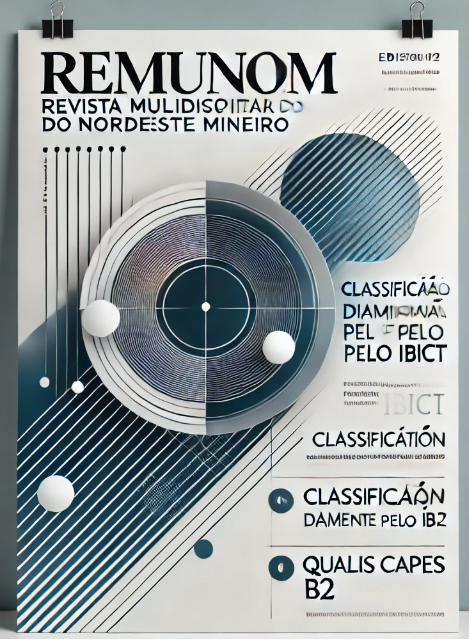BIODEGRADATION OF ACRYLIC-STYRENE COPOLYMER WITH REDUCTION OF TOXIC EFFECT IN CUCUMIS ANGURIA L.
DOI:
https://doi.org/10.61164/rmnm.v9i1.3939Keywords:
Bioremediation, Ecotoxicity, ResinsAbstract
Synthetic polymers offer several industrial applications, however their persistence in the environment denotes a challenge. This work assessed the use of an acrylic-styrene copolymer (ASC) as the sole of carbon by Pseudomonas aeruginosa TGC04 and the ecotoxicological effects of the metabolites on germination and development of Cucumis anguria L. (Gherkin). The experiment was carried out in flasks containing minimal mineral medium added with ASC 1% and incubated for 72h at 30ºC. The contaminant reduction was 5,01%, determined by gravimetry. Compared to the control, it resulted in a partial recovery of plant development and demonstrated a significant difference in root biomass (p=0.041) and a tendency to significance in the aerial part biomass (p=0.065), i.e., stem and leaves. In conclusion, P. aeruginosa TGC04 showed potential for use in bioremediation.
References
AALTO-KORTE, K. Acrylic resins. In: MAIBACH, H.I. (ed.). Kanerva’s occupational dermatology. Cham: Springer, 2019. p. 737-756.
ALEID, G.M.; ALSHAMMARI, A.S.; TRIPATHY, D.B.; GUPTA, A.; AHMAD, S. Polymeric surfactants: recent advancement in their synthesis, properties, and industrial applications. Macromolec Chem Physics. v. 224, n. 17, p. 2300107, 2023. https://doi.org/10.1002/macp.202300107
ALI, S.S.; ELSAMAHY, T.; AL-TOHAMY, R.; ZHU, D.; MAHMOUD, Y.A.G.; ABDELKAREEM, M.A.; SUN, J. Plastic wastes biodegradation: mechanisms, challenges and future prospects. Sci Total Environ. v. 780, p. 146590, 2021. https:/doi.org/10.1016/j.scitotenv.2021.146590
BOOTH, A.M.; HERNANDEZ, L.M.; RODRIGUEZ, D.M.; WATSON, S.A.; SMITH, J.D.; THOMPSON, R.C. Uptake and toxicity of methylmethacrylate-based nanoplastic particles in aquatic organisms. Environ Toxicol Chem. v. 35, n. 7, p. 1641-1649, 2015. https:/doi.org/10.1002/etc.3076
CAVALCANTI, T.G.; VIANA, A.A.G.; GUEDES, T.P.; FREIRE, A.S.; TRAVASSOS, R.A.; VASCONCELOS, U. Seed options for toxicity tests in soils contaminated with oil. Can J Pure Appl Sci. v. 10, n. 3, p. 4039-4045, 2016.
DEMIRORS, M. Styrene polymers and copolymers. In: KROSCHWITZ, J.I. (ed.). Applied Polymer Science: 21st century. New York: Wiley, 2000. p. 93-106.
DURVAL, I.; RUFINO, R.; SARUBBO, L. Biosurfactant as an environmental remediation agent: toxicity, formulation, and application in the removal of petroderivate in sand and rock walls. Biosci Res Agric Chem. v. 12, n. 1, p. 34-48, 2022. https:/doi.org/10.10.33263/BRIAC121.034048
ENERIJIOFI, K.E. Bioremediation of environmental contaminants: a sustainable alternative to environmental management. In: SINGH, S. N. (ed.). Bioremediation for environmental sustainability. London: Elsevier, 2021. p. 461-480.
FILLOUX, A.; RAMOS, J-L. Pseudomonas aeruginosa: biology, pathogenesis and control strategies. Cham: Springer Nature, 2022.
FRANÇA, F.P.; MUTECA, F.F.L.; OLIVEIRA, F.J.S. Biorremediation of fluvial sediment contaminated by Angolan crude oil. Braz J Petrol Gas. v. 8, p. 139–149, 2014. https://doi.org/10.5419/bjpg2014-0013
GAYTÁN, I.; BURELO, M.; LOZA-TAVERA, H. Current status on the biodegradability of acrylic polymers: microorganisms, enzymes and metabolic pathways involved. Appl Microbiol Biotechnol. v. 105, n. 3, p. 991-1006, 2021. https://doi.org/10.1007/s00253-020-11073-1
GHADAMGAHI, F.; TARIGHI, S.; TAHERI, P.; SARIPELLA, G.V.; ANZALONE, A.; KALYANDURG, P.B.; CATARA, V.; ORTIZ, R.; VETUKURI, R.R. Plant growth-promoting activity of Pseudomonas aeruginosa FG106 and its ability to act as a biocontrol agent against potato, tomato and taro pathogens. Biology, v. 11, n. 1, p. 140, 2022. https://doi.org/10.3390/biology11010140
HU, F.; WANG, P.; LI, Y.; LING, J.; RUAN, Y.; YU, J.; ZHANG, L. Bioremediation of environmental organic pollutants by Pseudomonas aeruginosa: mechanisms, methods and challenges. Environ Res. v. 239, n. 1, p. 117211, 2023. https://doi.org/10.1016/j.envres.2023.117211
KOTOVA, I.B.; TAKTAROVA, Y.V.; TSAVKELOVA, E.A.; EGOROVA, M.A.; BUBNOV, I.A.; MALAKHOVA, D.V.; SHIRINKINA, L.I.; SOKOLOVA, T.G.; BONCH-OSMOLOVSKAYA, E.A. Microbial degradation of plastics and approaches to make it more efficient. Microbiology. v. 90, p. 671-701, 2021. https://doi.org/10.1134/S0026261721060084
KWON, B.G.; MOON, K. Physicochemical properties of styrene oligomers in the environment. Sci Total Environ. v. 683, p. 216–220, 2019. https://doi.org/10.1016/j.scitotenv.2019.05.301
LEE, H.M.; KIM, H.R.; JEON, E.; YU, H.C.; LEE, S.; LI, J.; KIM, D-H. Evaluation of the biodegradation efficiency of four various types of plastics by Pseudomonas aeruginosa isolated from the gut extract of superworms. Microorganisms, v. 8, n. 9, p. 1341, 2020. https:doi.org/10.3390/microorganisms8091341
OELSCHLÄGEL, M.; KASCHABEK, S.R.; ZIMMERLING, J.; SCHLÖMANN, M.; TISCHLER, D. Co-metabolic formation of substituted phenylacetic acids by styrene-degrading bacteria. Biotechnol Rep. v. 6, p. 20-26, 2015. https://10.1016/j.btre.2015.01.003
ROZMAN, U.; KALČÍKOVÁ, G. The first comprehensive study evaluating the ecotoxicity and biodegradability of water-soluble polymers used in personal care products and cosmetics. Ecotoxicol Environ Saf. v. 228, p. 113016, 2021. https://doi.org/10.1016/j.ecoenv.2021.113016
TEJERA-GARCIA, R.; CONNELL, L.; SHAW, W.A.; KINNUNEN, P.K.J. Gravimetric determination of phospholipid concentration. Chem Physics Lip. v. 165, n. 6, p. 689-695, 2012. https://doi.org/10.1016/j.chemphyslip.2012.06.005
WAGHUNDE, R.R.; SABALPARA, A.N. Impact of Pseudomonas spp. on plant growth, lytic enzymes and secondary metabolites production. Front Agron. v. 3, p. 752196, 2021. https://doi.org/10.3389/fagro.2021.752196
WOOD, S. J.; KUZEL, T.M.; SHAFIKHANI, S H. Pseudomonas aeruginosa: infections, animal modeling, and therapeutics. Cells, v. 12, n. 1, p. 199, 2023. https://doi.org/10.3390/cells12010199
XU, H.; CHEN, C.; PANG, Z.; ZHANG, G.; ZHANG, W.; KAN, H. Effects of microplastics concentration on plant root traits and biomass: experiment and meta-analysis. Ecotoxicol Environ Saf. v. 285, p. 117038, 2024. https://doi.org/10.1016/j.ecoenv.2024.117038
Downloads
Published
How to Cite
Issue
Section
License
Copyright (c) 2025 Revista Multidisciplinar do Nordeste Mineiro

This work is licensed under a Creative Commons Attribution-NonCommercial-ShareAlike 4.0 International License.




